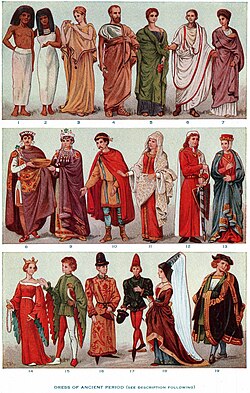History of Clothing
Sweety KarlakClothing (also known as clothes, garments, dress, apparel, or attire) is any item worn on a human body.
Typically, clothing is made of fabrics or textiles, but over time it has included garments made from animal skin and other thin sheets of materials and natural products found in the environment, put together.
The wearing of clothing is mostly restricted to human beings and is a feature of all human societies. The amount and type of clothing worn depends on gender, body type, social factors, and geographic considerations.
Garments cover the body, footwear covers the feet, gloves cover the hands, while hats and headgear cover the head, and underwear covers the intimate parts.
Clothing serves many purposes:
it can serve as protection from the elements, rough surfaces, sharp stones, rash-causing plants, and insect bites, by providing a barrier between the skin and the environment. Clothing can insulate against cold or hot conditions, and it can provide a hygienic barrier, keeping infectious and toxic materials away from the body. It can protect feet from injury and discomfort or facilitate navigation in varied environments.
Clothing also provides protection from ultraviolet radiation. It may be used to prevent glare or increase visual acuity in harsh environments, such as brimmed hats. Clothing is used for protection against injury in specific tasks and occupations, sports, and warfare. Fashioned with pockets, belts, or loops, clothing may provide a means to carry things while freeing the hands.
Clothing has significant social factors as well.Wearing clothes is a variable social norm. It may connote modesty. Being deprived of clothing in front of others may be embarrassing. In many parts of the world, not wearing clothes in public so that genitals, breast, or buttocks are visible could be considered indecent exposure. Pubic area or genital coverage is the most frequently encountered minimum found cross-culturally and regardless of climate, implying social convention as the basis of customs. Clothing also may be used to communicate social status, wealth, group identity, and individualism.
Some forms of personal protective equipment amount to clothing, such as coveralls, chaps or a doctor's white coat, with similar requirements for maintenance and cleaning as other textiles (boxing gloves function both as protective equipment and as a sparring weapon, so the equipment aspect rises above the glove aspect). More specialized forms of protective equipment, such as face shields are classified as protective accessories. At the far extreme, self-enclosing diving suits or space suits are form-fitting body covers, and amount to a form of dress, without being clothing per se, while containing enough high technology to amount to more of a tool than a garment. This line will continue to blur as wearable technology embeds assistive devices directly into the fabric itself; the enabling innovations are ultra low power consumption and flexible electronic substrates.
Clothing in history, showing (from top). Egyptians, Ancient Greeks, Romans; Byzantines, Franks; and thirteenth through fifteenth century Europeans
Clothing also hybridizes into a personal transportation system (ice skates, roller skates, cargo pants, other outdoor survival gear, one-man band) or concealment system (stage magicians, hidden linings or pockets in tradecraft, integrated holsters for concealed carry, merchandise-laden trench coats on the black market — where the purpose of the clothing often carries over into disguise). A mode of dress fit to purpose, whether stylistic or functional, is known as an outfit or ensemble.
Early use
Estimates of when humans began wearing clothes vary from 40,000 to as many as 3 million years ago. A study in 2003 suggested humans were wearing clothing at least 100,000 years ago from evidence about lice. Human body louse cannot live outside of clothing, dying after only a few hours without shelter. This strongly implies that the date of the body louse's speciation from its parent, Pediculus humanus, can have taken place no earlier than the earliest human adoption of clothing. This date, at which the body louse (P. humanus corporis) diverged from both its parent species and its sibling subspecies, the head louse (P. humanus capitis), has been estimated to between 40,000 to 170,000 years before present.
However, recent transcriptome analyses casts doubt on whether lice provide a means to date the origin of clothes since it has found that "body and head lice were almost genetically identical. Indeed, the phenotypic flexibility associated with the emergence of body lice, is probably a result of regulatory changes, perhaps epigenetic in origin, triggered by environmental signals."
Dating with direct archeological evidence produces dates consistent with those of lice. In September 2021, scientists reported evidence of clothes being made 120,000 years ago based on findings in deposits in Morocco.
The development of clothing is deeply connected to human evolution, with early garments likely consisting of animal skins and natural fibers adapted for protection and social signaling.
According to anthropologists and archaeologists, the earliest clothing likely consisted of fur, leather, leaves, or grass that was draped, wrapped, or tied around the body. Knowledge of such clothing remains inferential, as clothing materials deteriorate quickly compared with stone, bone, shell, and metal artifacts. Archeologists have identified very early sewing needles of bone and ivory from about 30,000 BC, found near Kostenki, Russia in 1988, and in 2016 a needle at least 50,000 years old from Denisova Cave in Siberia made by Denisovans. Dyed flax fibers that date back to 34,000 BC and could have been used in clothing have been found in a prehistoric cave in Georgia.
The oldest known piece of woven clothing is the Tarkhan dress, an over 5000 year old linen garment.

